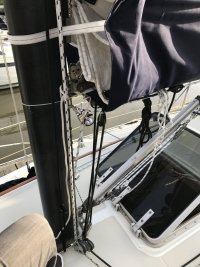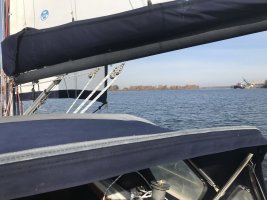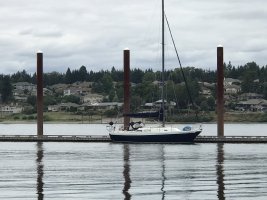One definite answer & one possible answer
Frank Langer started this thread wanting to know how many E/30+'s were built. This is only a
possible answer. Spirit's serial number is 721. I have yet to come across anyone with a serial number higher than that. Given that the serial numbers for the E/30+'s began with 501 and assuming no gaps, that would mean that there were at least 221 of these built.
According to the document that I excerpted earlier about serial numbers for Ericson models, the 30-foot models & their years of production go as follows:
E/30 – I # 1 (1966) thru # 150 (1970)
E/30 – II # 1 (1977) thru # 47 (1979)
E/30+ # 501 (1979) thru #
Now, during the thread, I asked
Seth if he thought the hulls for the E/30 - II and the E/30+ were the same design/mold. Here is the answer that I received from Bruce King via his wife, Pam:
bruce king <bruceking245@adelphia.net> wrote:
Hi Mr. Petrick,
Yes, Bruce said the same hull design was used for both the E/30+ and the E/30 II (except for the rudder). However, the original and earliest hull design for these boats is dated 1977. If I'm missing something here, just let me know.
Regards,
Pam King
So, the answer is it IS the same hull for both models. However, the reason that I wanted to know this was because I was hoping that the E30 - II was in production as of or prior to 1975. According to the info from the serial number document, they were only built from 1977 - 1979. I've attached the serial number document for anyone who has any interest.
If any member has an E/30+ with a serial number higher than 721, I think we'd all be interested in hearing about it.
Using Spirit's HIN (ERY30721J687), here's the breakdown on interpreting a Hull Identification Number (HIN) to help:
- the first three characters (characters 1 thru 3) indicate the name of the mfgr...ERY = Ericson
- the next two characters (characters 4 & 5) indicate the LOA of the boat...30 = 30 feet
- the next three characters (characters 6 thru 8) give the serial number of the boat...721
- the next two characters (characters 9 & 10) are
either the date of certification (i.e., it is certified to be in compliance with all safety standards as of the first day of the month indicated in the 9th character)
or the date that the building of this boat began with the 9th character equalling the month using a letter (i.e., A= January, B = February, etc.) and the 10th character is the year of the decade for the model...so Spirit's 9th & 10th characters are J6 = October of 1986,
- the last two characters = the model year of the boat...87.
I hope this helps.

Regards,
Ed









